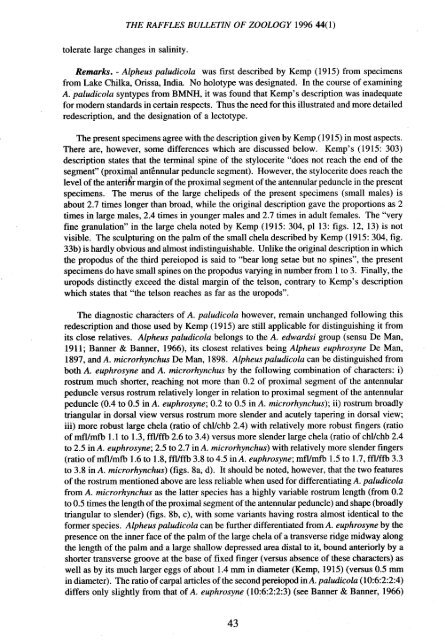a new species of freshwater snapping shrimp, alpheus cyanoteles
a new species of freshwater snapping shrimp, alpheus cyanoteles
a new species of freshwater snapping shrimp, alpheus cyanoteles
You also want an ePaper? Increase the reach of your titles
YUMPU automatically turns print PDFs into web optimized ePapers that Google loves.
Remarks. - Alpheus paludicola was first described by Kemp (1915) from specimens<br />
from Lake Chilka, Orissa, India No holotype was designated. In the course <strong>of</strong> examining<br />
A. paludicola syntypes from BMNH, it was found that Kemp's description was inadequate<br />
for modem standards in certain respects. Thus the need for this illustrated and more detailed<br />
redescription, and the designation <strong>of</strong> a lectotype.<br />
The present specimens agree with the description given by Kemp (1915) in most aspects.<br />
There are, however, some differences which are discussed below. Kemp's (1915: 303)<br />
description states that the terminal spine <strong>of</strong> the stylocerite "does not reach the end <strong>of</strong> the<br />
segment" (proximal antennular peduncle segment). However, the stylocerite does reach the<br />
level <strong>of</strong> the anteribr margin <strong>of</strong> the proximal segment <strong>of</strong> the antennular peduncle in the present<br />
specimens. The merus <strong>of</strong> the large chelipeds <strong>of</strong> the present specimens (small males) is<br />
about 2.7 times longer than broad, while the original description gave the proportions as 2<br />
times in large males, 2.4 times in younger males and 2.7 times in adult females. The "very<br />
fine granulation" in the large chela noted by Kemp (1915: 304, pI 13: figs. 12, 13) is not<br />
visible. The sculpturing on the palm <strong>of</strong>the small chela described by Kemp (1915: 304, fig.<br />
33b) is hardly obvious and almost indistinguishable. Unlike the original description in which<br />
thepropodus <strong>of</strong> the third pereiopod is said to "bear long setae but no spines", the present<br />
specimens do have small spines on the propodus varying in number from 1 to 3. Finally, the<br />
uropods distinctly exceed the distal margin <strong>of</strong> the telson, contrary to Kemp's description<br />
which states that "the telson reaches as far as the uropods".<br />
The diagnostic characters <strong>of</strong> A. paludicola however, remain unchanged following this<br />
redescription and those used by Kemp (1915) are still applicable for distinguishing it from<br />
its close relatives. Alpheus paludicola belongs to the A. edwardsi group (sensu De Man,<br />
1911; Banner & Banner, 1966), its closest relatives being Alpheus euphrosyne De Man,<br />
1897, and A. microrhynchus De Man, 1898. Alpheus paludicola can be distinguished from<br />
both A. euphrosyne and A. microrhynchus by the following combination <strong>of</strong> characters: i)<br />
rostrum much shorter, reaching not more than 0.2 <strong>of</strong> proximal segment <strong>of</strong> the antennular<br />
peduncle versus rostrum relatively longer in relation to proximal segment <strong>of</strong> the antennular<br />
peduncle (0.4 to 0.5 in A. euphrosyne; 0.2 to 0.5 in A. microrhynchus); ii) rostrum broadly<br />
triangular in dorsal view versus rostrum more slender and acutely tapering in dorsal view;<br />
iii) more robust large chela (ratio <strong>of</strong> chllchb 2.4) with relatively more robust fingers (ratio<br />
<strong>of</strong>mf1lmfb 1.1 to 1.3, ffl/ffb 2.6 to 3.4) versus more slender large chela (ratio <strong>of</strong> chllchb 2.4<br />
to 2.5 in A. euphrosyne; 2.5 to 2.7 in A. microrhynchus) with relatively more slender fingers<br />
(ratio <strong>of</strong>mf1lmfb 1.6 to 1.8, ffl/ffb 3.8 to 4.5 in A. euphrosyne; mfl/mfb 1.5 to 1.7, fWffb 3.3<br />
to 3.8 in A. microrhynchus) (figs. 8a, d). It should be noted, however, that the two features<br />
<strong>of</strong> the rostrum mentioned above are less reliable when used for differentiating A. paludicola<br />
from A. microrhynchus as the latter <strong>species</strong> has a highly variable rostrum length (from 0.2<br />
to 0.5 times the length <strong>of</strong> the proximal segment <strong>of</strong> the antennular peduncle) and shape (broadly<br />
triangular to slender) (figs. 8b, c), with some variants having rostra almost identical to the<br />
former <strong>species</strong>. Alpheus paludicola can be further differentiated from A. euphrosyne by the<br />
presence on the inner face <strong>of</strong> the palm <strong>of</strong> the large chela <strong>of</strong> a transverse ridge midway along<br />
the length <strong>of</strong> the palm and a large shallow depressed area distal to it, bound anteriorly by a<br />
shorter transverse groove at the base <strong>of</strong> fixed finger (versus absence <strong>of</strong> these characters) as<br />
well as by its much larger eggs <strong>of</strong> about 1.4 mm in diameter (Kemp, 1915) (versus 0.5 mm<br />
in diameter). The ratio <strong>of</strong> carpal articles <strong>of</strong> the second pereiopod in A. paludicola (10:6:2:2:4)<br />
differs only slightly from that <strong>of</strong> A. euphrosyne (10:6:2:2:3) (see Banner & Banner, 1966)
















